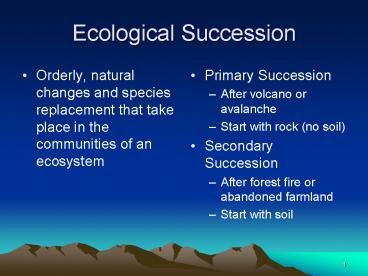Ecological Succession PowerPoint PPT Presentation
1 / 23
Title: Ecological Succession
1
Ecological Succession
- Orderly, natural changes and species replacement
that take place in the communities of an ecosystem
- Primary Succession
- After volcano or avalanche
- Start with rock (no soil)
- Secondary Succession
- After forest fire or abandoned farmland
- Start with soil
2
Primary Succession
3
Primary Succession
- Pioneer Species first species on bare land/rock
is lichen or moss - Breakdown of rock and decay of moss will build up
the soil so other plants can survive
- Overtime additional habitats develop
4
Primary Succession
- Producers are always present before consumer
- Ends with climax community
- Stable, mature community which undergoes little
or no change in species - Can take hundreds of years to develop a climax
community starting with rock
5
Secondary Succession
6
Secondary Succession
- Sequence of community changes that take place
after a community is disrupted by natural
disasters or human actions - Occurs in places that previously contained life
- On land that contains soil, so takes less time
than primary succession to reach climax community
7
Primary or Secondary Succession?
8
Chapter 3 Communities, Biomes and Ecosystems
- 3.2 Terrestrial Biomes
9
Effects of Latitude and Climate
- Weather is the condition of the atmosphere at a
specific place and time. - One of the keys to understanding these
communities is to be aware of latitude and
climatic conditions.
10
Effects of Latitude and Climate
- The distance of any point on the surface of Earth
north or south from the equator is latitude.
11
Effects of Latitude and Climate
- The average weather conditions in an area,
including temperature and precipitation, describe
the areas climate. - The graph shows how temperature and precipitation
influence the communities.
12
Effects of Latitude and Climate
- Biomes are classified by their plants,
temperature, and precipitation.
13
Biomes
- Large group of ecosystems that share the same
type of climax community - Identified by climax community of plants rather
than animals because plants dont migrate. - Plants are a better indicator of long term
characteristics of a biome
14
Major Biomes of the World
15
Terrestrial Biomes
- From the North Pole
- Tundra
- Taiga
- Temperate Forest
- Grassland
- Desert
- Tropical Rain Forest
- Each have characteristic abiotic and biotic
factors
16
Aquatic Ecosystems
- Temperature and precipitation reflect its
associated terrestrial biome
- Freshwater biomes
- Lakes, streams, rivers, ponds
- Marine Biomes
- Oceans and seas
- Study by amount of sunlight
- Specialty biomes estuary and intertidal zone
Intertidal zone
17
Freshwater Ecosystems
- Only about 2.5 percent of the water on Earth is
freshwater.
18
Freshwater Ecosystems
- The characteristics of rivers and streams change
during the journey from the source to the mouth.
19
Freshwater Ecosystems
- Fast-moving rivers and streams prevent much
accumulation of organic materials and sediment. - Usually, there are fewer species living in the
rapid waters. - In slow-moving water, insect larvae are the
primary food source for many fish, including
American eel, brown bullhead catfish, and trout.
20
Freshwater Ecosystems
- The temperature of lakes and ponds varies
depending on the season.
21
Transitional Aquatic Ecosystems
- Areas of land such as marshes, swamps, and bogs
that are saturated with water and that support
aquatic plants are called wetlands
22
Marine Ecosystems
- The intertidal zone is a narrow band where the
ocean meets land. - Communities are constantly changing in this
environment as a result of disturbance.
23
Open Ocean Systems
- The photic zone is shallow enough that sunlight
is able to penetrate. - Below the photic zone lies the aphotic zonean
area where sunlight is unable to penetrate. - The benthic zone is an area along the ocean floor
that consists of sand, silt, and dead organisms.

